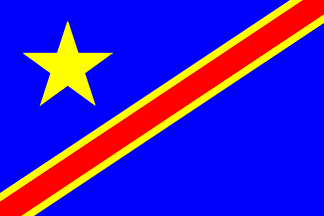
Last modified: 2004-06-19 by jarig bakker
Keywords: congo |
Links: FOTW homepage |
search |
disclaimer and copyright |
write us |
mirrors
 by Zeljko Heimer, 23 May 2004
See also:
by Zeljko Heimer, 23 May 2004
See also:
The height (of the flag) is equal to two-thirds of (its) length (150cms
x 225cms).
The diagonal stripe is 16cms wide; the width of the fimbriation is
5 cms.
The star is contained within a circle of 65cms diameter, whose centre
is at the meeting point of three lines bisecting the angles formed above
the diagonal stripe.
----------
All the above were translated from the originals by myself, however,
on the evidence of two stamps issued in 1970 (as reproduced in Flagmaster
087 of Autumn 1997) either the last law was ineffective or was replaced
by another, because the flags shown have much wider stripes and a smaller
star. More importantly, these stamps show the diagonal as being contained
within the width of the flag
Christopher Southworth, 21 May 2004
As was already proven in several cases, stamps tend to be very untrustworthy
evidence in vexillology. The stamps, especially those of Third World countires
are made far away from home and the artists drawing them have little knowlage
of the local reality. The errors even when found then tend to be ignored
for the sake of the cost their correction would require, especialy if the
errors were not that large and would be spotted only be a very experienced
eye :-)
Well, not saying that Chris is wrong here, but the great Smith
shows the flag with the "usual" diagonal (p. 202). Also I would argue that
if the legislator thought anything else then the "usual" diagonal, they
would have said so.
Zeljko Heimer, 23 May 2004
Is it not more likely that the designer of the stamps would have given
the flags a conventional diagonal in default of any concrete information
to the contrary?
Pedersen (1970) shows the flag with
an east-west diagonal, rather than with a conventional one, and (as did
I) excludes the fimbriation.(placing the lower band on the length).
Christopher Southworth, 23 May 2004
1966 flag, with the "usual" diagonal. For the time being I ignore the
"unusual" diagonal Chris Southworth suggested, but I shall gladly redraw
them all again if it turns out correct.
Zeljko Heimer, 23 May 2004
![[1966 flag construction sheet]](../images/c/cd'66.gif) by Zeljko Heimer, 23 May 2004
by Zeljko Heimer, 23 May 2004
1966 flag construction details. The bisectoring lines of the upper blue
triangle are just an other way of saying that the circle circumscribing
the star is equidistant from all thtee triangle sides.
Zeljko Heimer, 23 May 2004